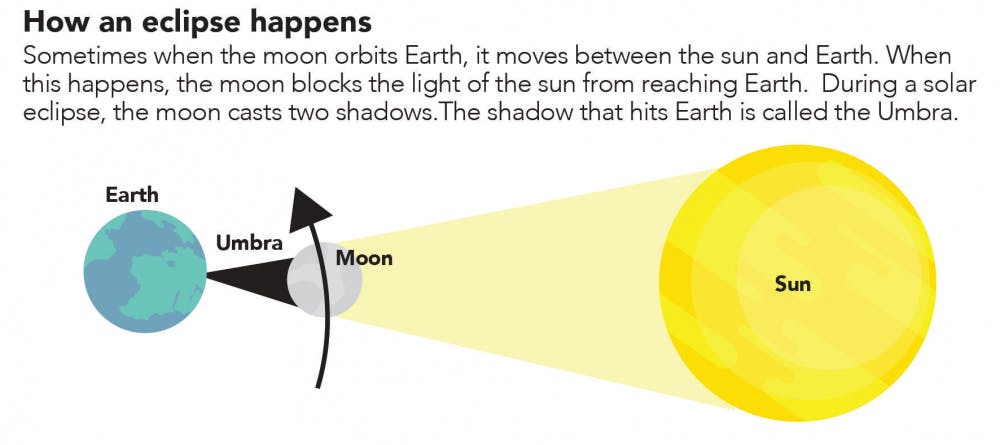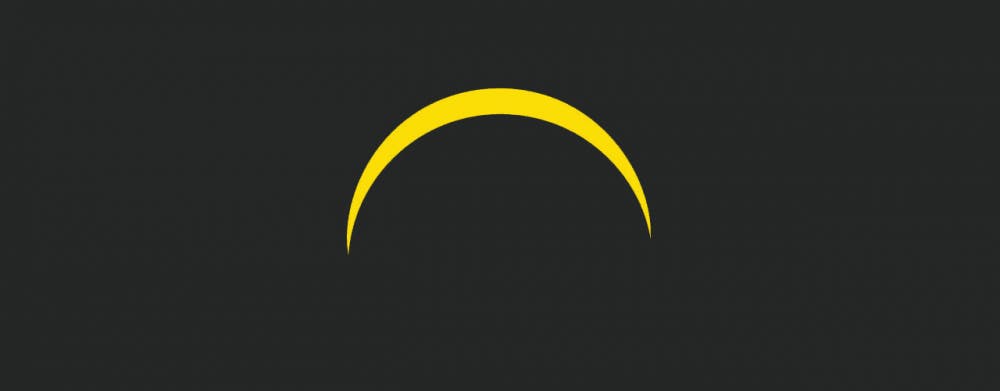Solar eclipses happen somewhere on Earth every 18 months or so, but this year’s eclipse is unique because of the path of totality it will take across the United States.
The phenomenon, dubbed as The Great American Eclipse, will begin in the Pacific Northwest in Oregon and travel southeast until it passes over South Carolina and into the Atlantic Ocean on Aug. 21.

Maureen Langley, Unified Media
The last time a solar eclipse's path of totality crossed from the Pacific to Atlantic Ocean was on June 8, 1918, starting in Washington and ending Florida.
Indiana residents will not be able to see a total eclipse on Aug. 21, since it is not in the direct path of totality, but there is anticipated to be approximately 93 percent peak coverage of the sun estimated for Muncie residents.

Maureen Langley, Unified Media
That doesn’t mean it’s safe to look at the sun without taking a couple of precautions first, however.
“The temptation is that when people hear the word 90 percent, they think ‘Oh that means it’s 90 percent safe [to look at the sun],’” said Ron Kaitchuck, director of the Charles W. Brown Planetarium. “No, it’s still a hundred percent unsafe at that point, all that means is when you burn your eyes, the damage will be a bit less.”
Looking into a partial eclipse is the equivalent, if not more dangerous, than looking directly into the sun, making a pair of protective solar glasses a necessity. It’s also dangerous to take a photo of the eclipse with your cell phone or digital camera without taking precautionary measures first.

Maureen Langley, Unified Media
“Phones will be damaged just like your eyes would,” Kaitchuck said. “They have a lens and they focus light, they can be damaged.”
To ensure that students, faculty staff and visitors are safe, the university will be distributing 10,000 protective glasses leading up to the eclipse on the first day of class. Burris received 665 pairs of glasses on Aug. 11, 6,500 were handed out to university housing residents upon their move in from Aug. 13-16 and the others will be distributed around campus on Aug. 21.“The only safe way to watch the eclipse is through these filters,” Marc Ransford spokesperson for Ball State said. “Safety is paramount in this issue because you don’t anyone to burn out their eyes.”
Starting last school year and continuing through this summer, the planetarium has been showcasing “Eclipse: The Sun Revealed” which informs visitors about how to safely watch an eclipse. The planetarium has been selling glasses as a $2 donation, since they do not charge for their shows, and according to Dayna Thompson, assistant director of the Charles W. Brown Planetarium, they should sell out of the 5,000 glasses they have by August 21.
For those looking online, websites may try to sell protective solar glasses, but they are not always the proper kind for direct viewing of the sun Thompson says.
If the side of the sunglasses have ISO 12313-2 on them, then they comply with the international safety standard for filters for direct viewing of the Sun.
“A lot of the ones online, they’ll say they’re ISO, they’ll have a picture showing that, but they won’t have those numbers that are needed,” Thompson said. “Those, you can actually see you office lights and clouds in the sky when you look through them. You shouldn’t be able to see any of that, you should just be able to see the sun.”
“They’re so dense that the only thing you can see through them is the sun,” Kaitchuck added.
While there are dangers that come with looking at the eclipse, it’s also an experience that people may only be able to see a few times in their lifetime.
“Definitely get out and see it, don’t be afraid,” said Thompson. “If you do research and figure out what works and what doesn’t when it come to you program, definitely take the time to experience it to its fullest.”
Peak coverage of the partial eclipse will be over Muncie around 2:25 p.m., but the moon will be passing in front of the sun from 1-3:48 p.m.
